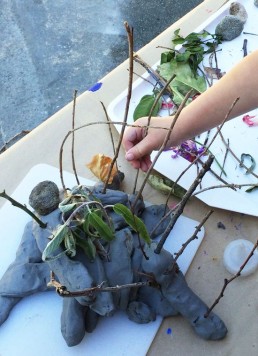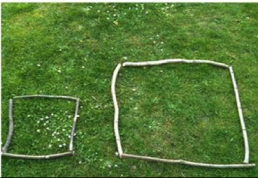Activity 5- Stick Models
Resources: Sticks and home made play dough or messy but fun naturally sourced mud or clay.
Easy make at home play dough recipe: https://www.youtube.com/watch?v=jv73CEzY1jg
Implementation
To extend on your 2D stick shapes, have a go making 3D shapes or models using your sticks and playdough/mud to hold them together.
You may have your own ideas of what works best for you
that you can also share with us.
What would you like your model to look like?
What you will use?
How will you? What else might work? What could you do differently?
What could you add? What does it remind you of?
Can you tell me about your model?
Intent
Characteristics of Effective Learning – Creating and Thinking Critically
Having their own ideas
- Thinking of ideas
- Finding ways to solve problems
- Finding new ways to do things
 Making links
Making links
- Making links and noticing patterns in their experience
- Making predictions
- Testing their ideas
- Developing ideas of grouping, sequences, cause and effect
Choosing ways to do things
- Planning, making decisions about how to approach a task,solve a problem and reach a goal
- Checking how well their activities are going
- Changing strategy as needed
- Reviewing how well the approach worked
Maths – Shape Space and Measure
22-36 months
- Notices simple shapes and patterns in pictures.
30-50 months
- Shows an interest in shape and space by playing with shapes or making arrangements with objects.
- Uses positional language.
- Shows interest in shape by sustained construction activity or by talking about shapes or arrangements.
- Uses shapes appropriately for tasks.
40-60 months
- Beginning to use mathematical names for ‘solid’ 3D shapes and ‘flat’ 2D shapes, and mathematical terms to describe shapes.
- Uses familiar objects and common shapes to create and recreate patterns and build models.
Expressive Arts and Design – Exploring using Media and Materials
30-50 months
- Uses various construction materials.
- Beginning to construct, stacking blocks vertically and horizontally, making enclosures and creating spaces.
- Joins construction pieces together to build and balance.
40-60 months
- Understands that different media can be combined to create new effects.
- Manipulates materials to achieve a planned effect.
- Constructs with a purpose in mind, using a variety of resources.
- Selects appropriate resources and adapts work where necessary.
- Selects tools and techniques needed to shape, assemble and join materials they are using.
Impact
Please use this space to record any findings, adaptions, reflections and quotes from your children. We would love you to email them back to us or share them on Tapestry.
Activity 4- Stick Shapes
Implementation
Resources: Sticks and any other loose parts
Use Sticks to make 2D shapes and Transient Art Pictures
Can you make a shape/picture with your sticks?
I wonder what shape you will make?
How will you make it?
I wonder how many sides it has?
What does it remind you of?
Is there anything you would like to add to your shape/picture?
Intent- Learning Goals
Maths – shape, space and measure
22-36 months
- Notices simple shapes and patterns in pictures.
- Beginning to categorise objects according to properties such as shape or size.
30-50 months
- Shows an interest in shape and space by playing with shapes or making arrangements with objects.
- Uses positional language.
- Shows interest in shape by sustained construction activity or by talking about shapes or arrangements.
- Shows interest in shapes in the environment
.• Uses shapes appropriately for tasks.
- Beginning to talk about the shapes of everyday objects, e.g. ‘round’ and ‘tall’.
40-60 months
- Beginning to use mathematical names for ‘flat’ 2D shapes, and mathematical terms to describe shapes.
- Selects a particular named shape.
- Can describe their relative position such as ‘behind’ or ‘next to’ • Uses familiar objects and common shapes to create and recreate patterns and build models.
Expressive Arts and Design – Being Imaginative
30-50 months
- Uses available resources to create props to support role-play.• Captures experiences and responses with a range of media, such as music, dance and paint and other materials or words.
40-60 months
- Create simple representations of events, people and objects.
Impact
Please use this space to record any findings, adaptations, reflections and quotes from your children.
Transient art is temporary so this could be an opportunity for your children to use cameras or iPads to take photos before their pictures/shapes are moved.
Technology
22-36 months
- Seeks to acquire basic skills in turning on and operating some ICT equipment
30-50 months
- Knows how to operate simple equipment, e.g. turns on CD player and uses remote control.
- Shows an interest in technological toys with knobs or pulleys, or real objects such as cameras or mobile phones.
40-60 months
- Uses ICT hardware to interact with age-appropriate computer Software
We would love you to email them back to us or share them on Tapestry.


